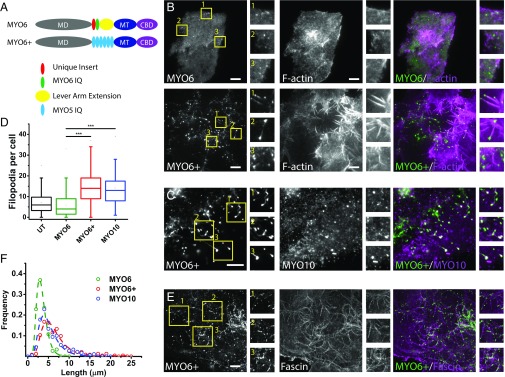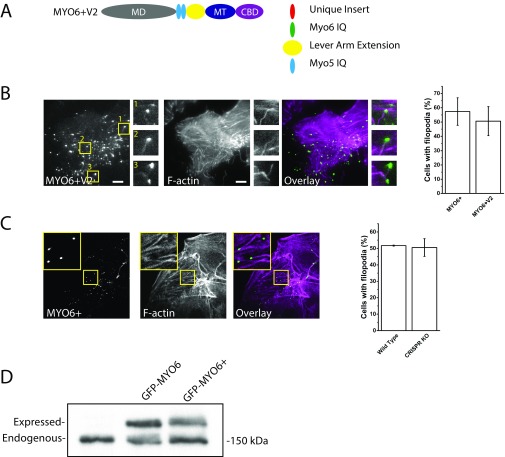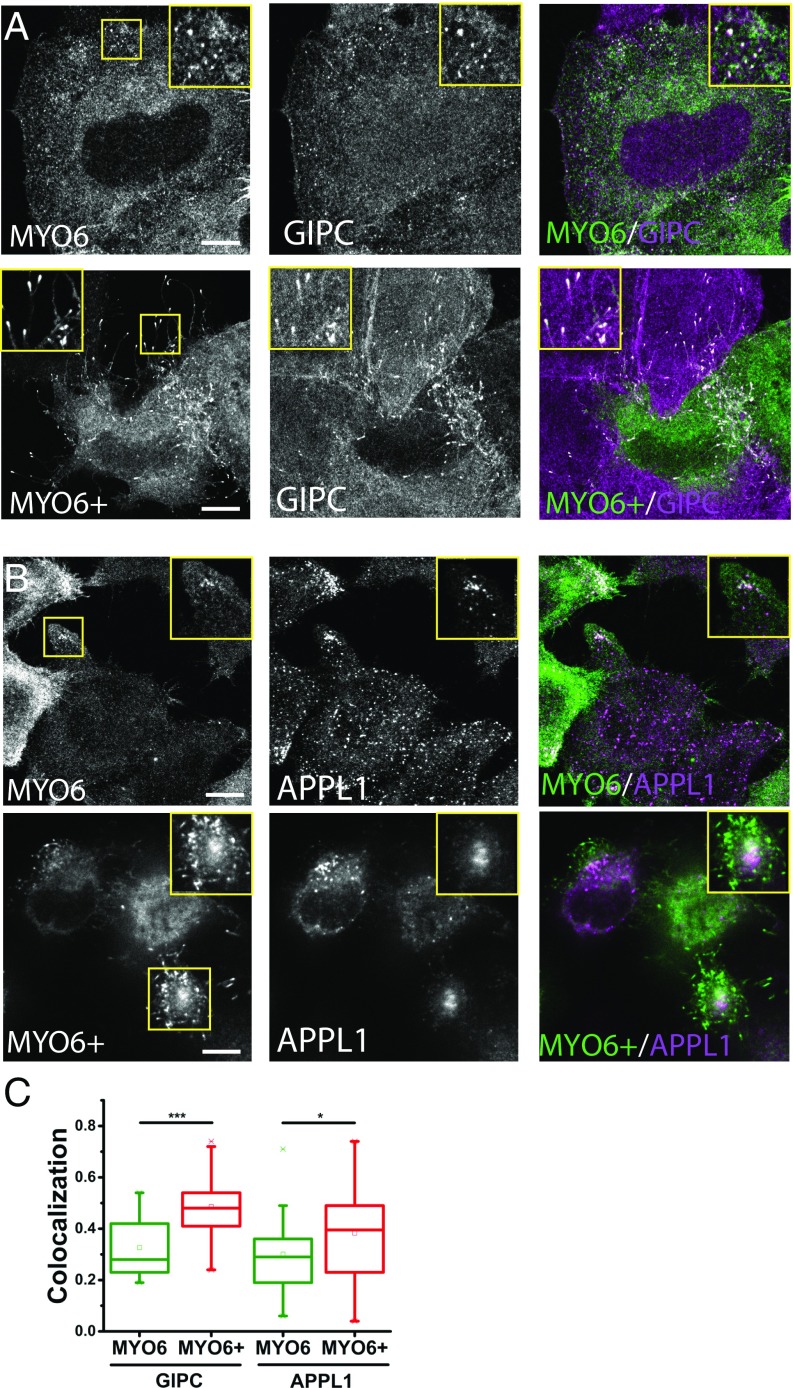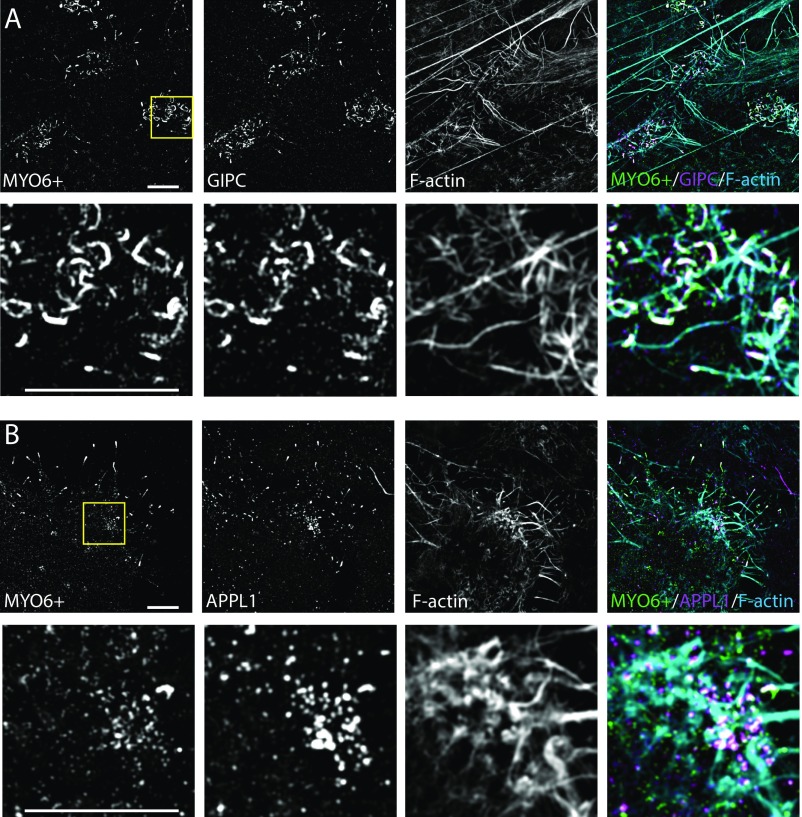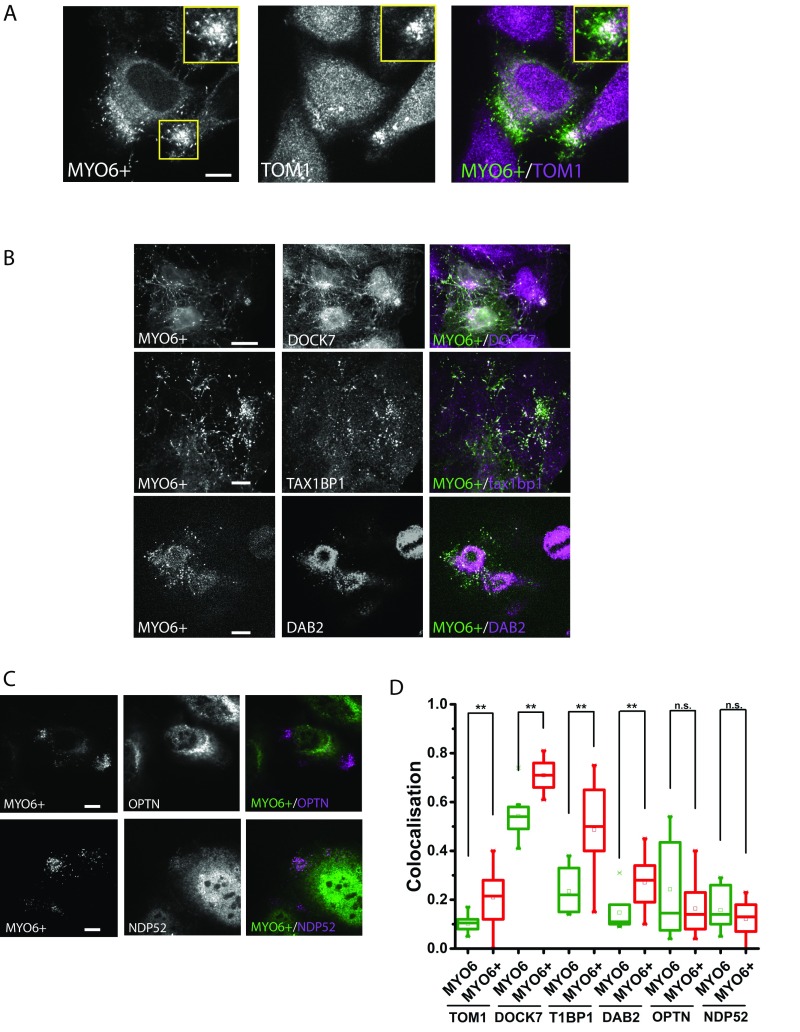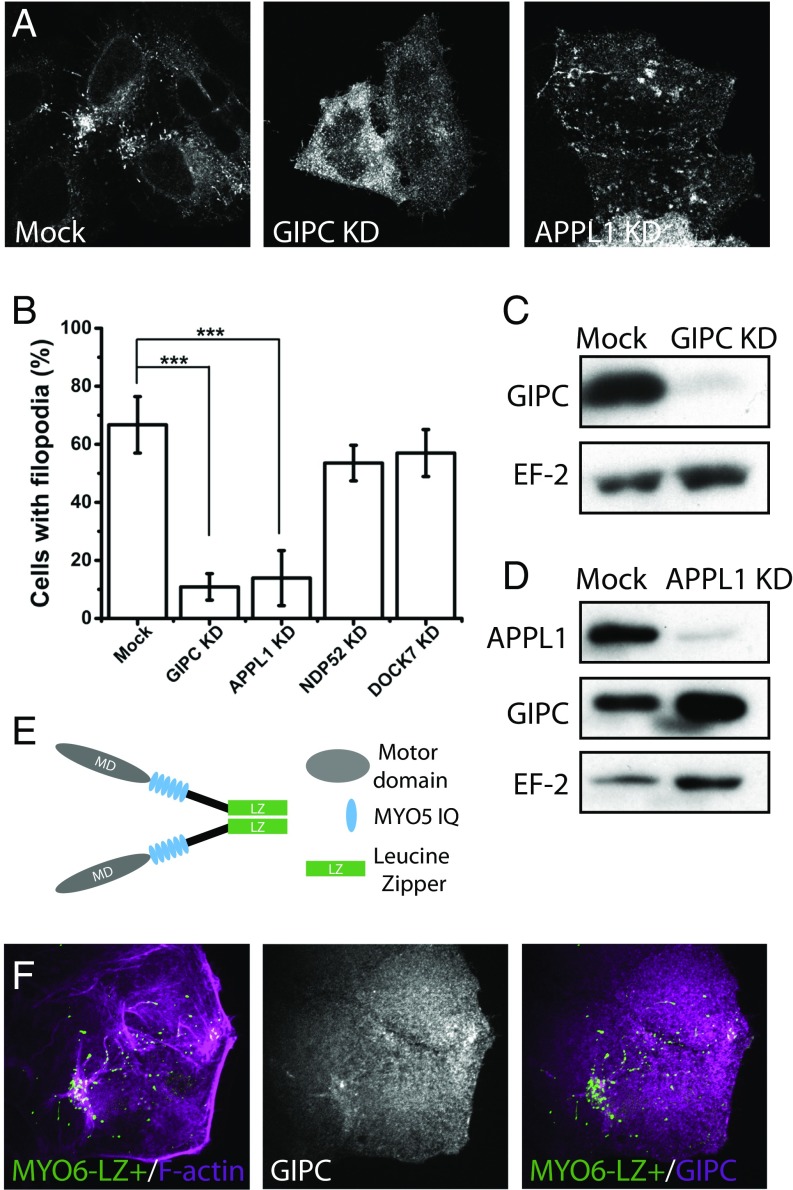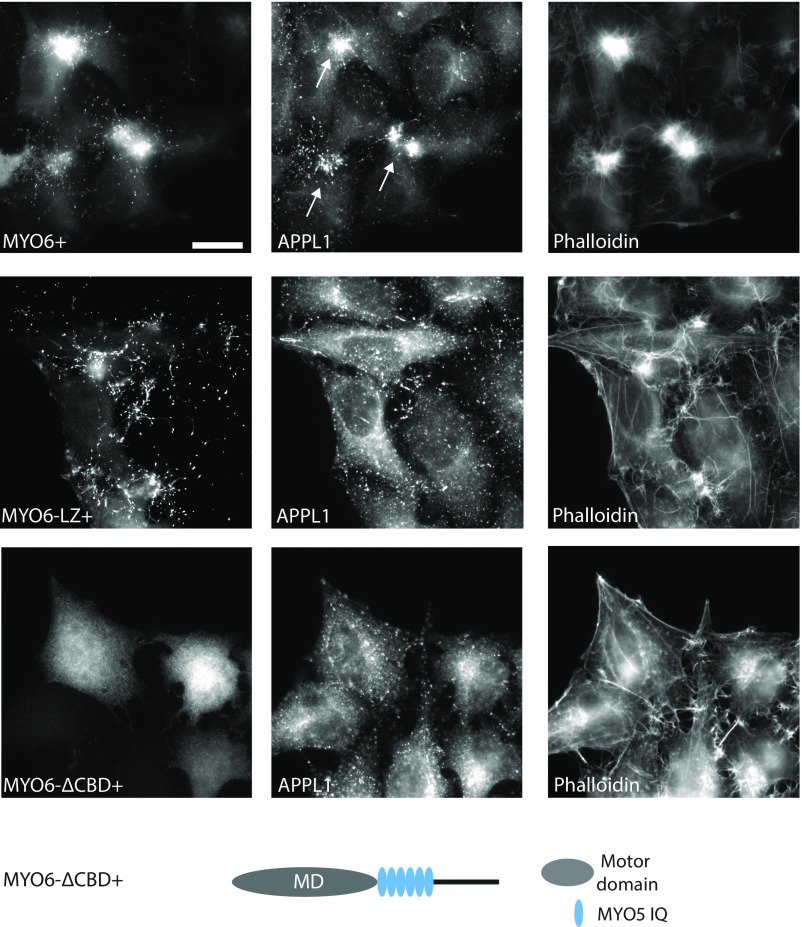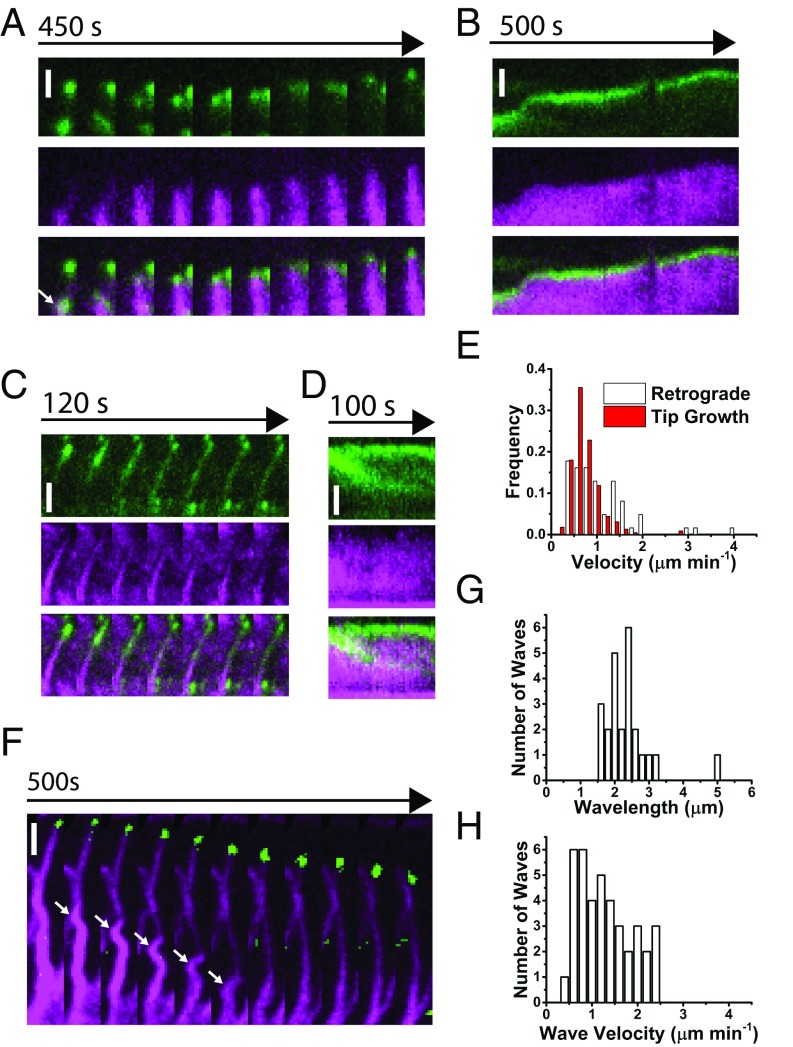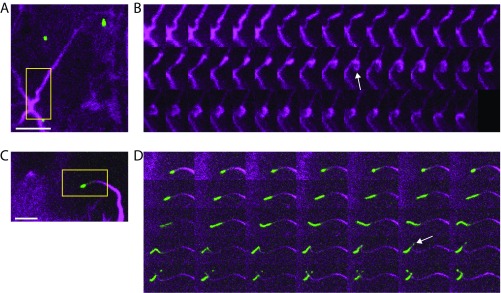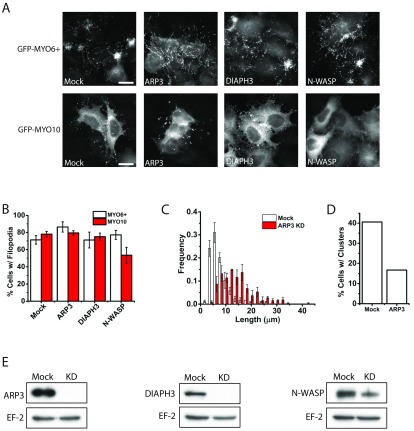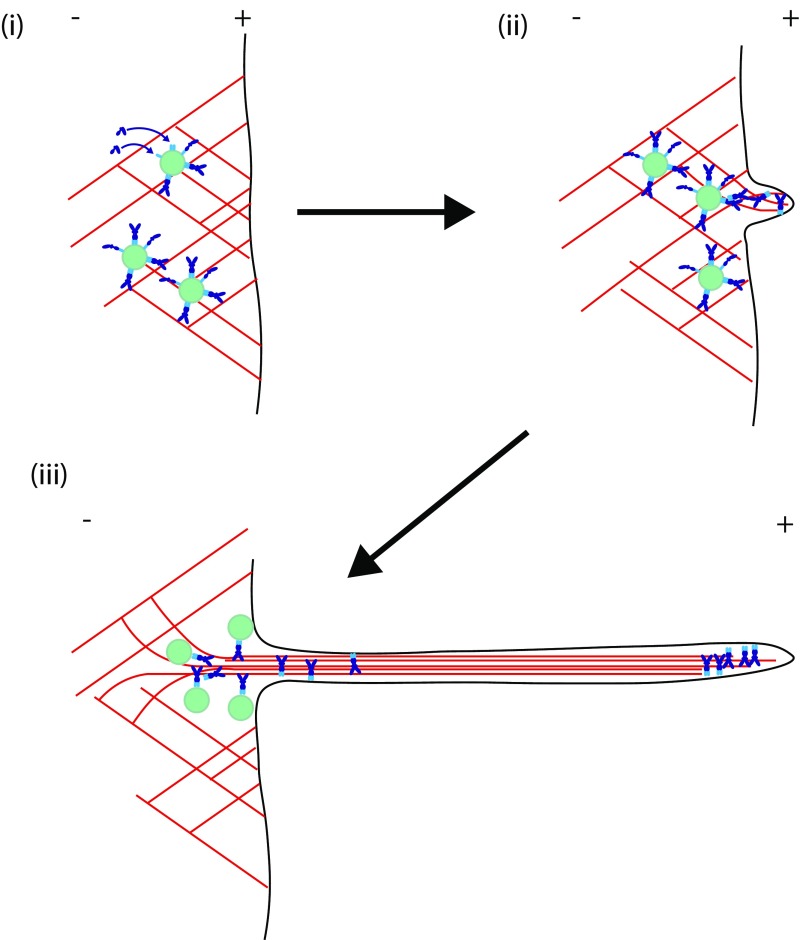Significance
How the mechanical properties of myosin motors relate to their functions in cells is poorly understood. Myosin VI (MYO6) is the only myosin that moves to the minus end of actin filaments, but the cellular requirement of this reverse movement is unknown. To investigate this question, we generated a mechanical mutant of MYO6, MYO6+, which moves to the plus end of actin filaments. This mutant causes clustering of signaling endosomes coupled to reorganization of cortical actin filaments into elongated filopodia. These two phenotypes depend on the multimerization of MYO6+ on the endosomal membrane induced by binding to lipids and adaptor proteins. Our results highlight the importance of endosomes for myosin-dependent regulation of cortical actin filaments in mammalian cells.
Keywords: unconventional myosins, filopodia, endosomes, actin dynamics, motor–cargo complexes
Abstract
Myosin VI (MYO6) is the only myosin known to move toward the minus end of actin filaments. It has roles in numerous cellular processes, including maintenance of stereocilia structure, endocytosis, and autophagosome maturation. However, the functional necessity of minus-end–directed movement along actin is unclear as the underlying architecture of the local actin network is often unknown. To address this question, we engineered a mutant of MYO6, MYO6+, which undergoes plus-end–directed movement while retaining physiological cargo interactions in the tail. Expression of this mutant motor in HeLa cells led to a dramatic reorganization of cortical actin filaments and the formation of actin-rich filopodia. MYO6 is present on peripheral adaptor protein, phosphotyrosine interacting with PH domain and leucine zipper 1 (APPL1) signaling endosomes and MYO6+ expression causes a dramatic relocalization and clustering of this endocytic compartment in the cell cortex. MYO6+ and its adaptor GAIP interacting protein, C terminus (GIPC) accumulate at the tips of these filopodia, while APPL1 endosomes accumulate at the base. A combination of MYO6+ mutagenesis and siRNA-mediated depletion of MYO6 binding partners demonstrates that motor activity and binding to endosomal membranes mediated by GIPC and PI(4,5)P2 are crucial for filopodia formation. A similar reorganization of actin is induced by a constitutive dimer of MYO6+, indicating that multimerization of MYO6 on endosomes through binding to GIPC is required for this cellular activity and regulation of actin network structure. This unique engineered MYO6+ offers insights into both filopodia formation and MYO6 motor function at endosomes and at the plasma membrane.
Myosin VI (MYO6) is a monomeric motor protein with a large working stroke (1), which takes processive 36-nm steps along actin filaments in vitro when dimerized (2). Uniquely among myosin motors, it takes these steps toward the minus end of actin filaments (3). In cells and tissues, MYO6 has been implicated in an ever-growing list of functions, including secretion, endocytosis, cell migration, stereocilia maintenance, and autophagy (4). It mediates these functions through interactions with a wide array of cargo adaptor proteins that bind to the tail region of MYO6, thereby localizing and potentially activating the motor through conformational change and unfolding of the lever arm (5) mediated by calcium (6). However, how the mechanical properties (for instance step size, duty ratio, stall force, etc.) and in particular the directionality of MYO6 relate to its biological roles is poorly understood.
Isolated, purified MYO6 is primarily monomeric (1), but can dimerize in vitro through interactions between the cargo binding domain and adaptor molecules (2, 7). Whether any of these adaptors are capable of inducing functional MYO6 dimers in cells is not known and there has been little definitive evidence as to whether MYO6 functions as a monomer or as a processive dimer in cells and how motor processivity relates to its biological function (8, 9).
The cellular requirement for MYO6 to move toward the minus end of actin filaments is similarly poorly understood. The organization of the actin network at the plasma membrane, where plus ends are found adjacent to the membrane and minus ends toward the cytoplasm, implies MYO6 has a role in retrograde transport along actin, away from the plasma membrane. However, in other locations where a role for MYO6 has been identified, such as at the Golgi complex or nascent autophagosomes, the organization of the actin network is poorly characterized and it is far from obvious why a minus-end motor would be required.
To begin to address these questions, we created a mutant of MYO6, MYO6+, which moves toward the plus end of actin filaments. Expression of this mutant in HeLa cells led to formation of filopodia and the reorganization cortical endosomes and MYO6 adaptor proteins. This suggests that MYO6 may play a transient and highly regulated role in actin organization around endosomes underneath the plasma membrane and potentially at its other sites of function. We further validate the role of MYO6 in mediating the interaction of peripheral endosomes with the actin cortex, initiating movement away from the plasma membrane.
Results
Expression of MYO6+ Reorganizes Actin at the Plasma Membrane.
To investigate the requirement of minus-end–directed movement of MYO6 for cellular function, we reengineered MYO6 into a plus-end–directed motor by replacing the unique insert and neck regions with the myosin V lever arm (Fig. 1A). Similar replacements in porcine MYO6 have been previously shown to lead to plus-end–directed movement in vitro (10). When this construct was transfected into HeLa cells, we observed a dramatic reorganization of the actin cortex with formation of filopodia-like (11) protrusions of actin, where MYO6+ accumulated at the tips (Fig. 1B). This observation is reminiscent of the previously reported accumulation of myosin X (12) and dimeric myosin VIIA (13) at tips of filopodia, indicating that MYO6+ was acting as a processive plus-end–directed motor in cells. A shorter replacement of the unique MYO6 neck region with only two isoleucine–glutamine calmodulin binding motifs (IQ) motifs (retaining the lever arm extension) led to a similar formation of filopodia (Fig. S1 A and B). To confirm whether MYO6+ was indeed accumulating at actin filament plus ends, we cotransfected GFP-MYO6+ with myosin X (MYO10) labeled with-mCherry (Fig. 1C). MYO6+ was observed to colocalize with MYO10, a protein known to induce filopodia and accumulate at filopodia tips (12). MYO6+ had a similar propensity to induce filopodia as MYO10 in HeLa cells (Fig. 1D), indicating that MYO6+ was functioning in a similar capacity. The actin-rich protrusions induced by MYO6+ were positive for fascin along the shaft (Fig. 1E), indicating they are indeed filopodia. We extracted the lengths of filopodia from total internal reflection fluorescence (TIRF) images and found they adopted a log-normal distribution (Fig. 1F), as previously reported for both filopodia (14) and neuronal spines (15). The mode length of this distribution is 5.66 ± 0.14 µm compared with 3.22 ± 0.04 µm in cells transfected with GFP-MYO6. The average length of filopodia in cells expressing GFP-MYO6+ is 6.3 ± 3.7 µm (SD, n = 233) compared with 2.95 ± 1.1 µm (SD, n = 149) in cells expressing wild-type GFP-MYO6 (P < 0.0001) and 5.3 ± 2.9 µm (SD, n = 180) in cells expressing GFP-MYO10 (in agreement with a previous report, ref. 12), indicating the activity of MYO6+ is capable of significantly increasing the length of filopodia. To assess the requirement for endogenous MYO6 in this process, we expressed MYO6+ in HeLa cells rendered null for MYO6 by modification with CRISPR/Cas9 (16). We found no difference in the propensity of GFP-MYO6+ to induce filopodia in these cells compared with wild-type HeLa cells, indicating that indeed expression of MYO6+ alone leads to the formation and elongation of filopodia with MYO6+ localized to the tip (Fig. S1C). Expression of GFP-MYO6+ did not affect the level of endogenous MYO6 (Fig. S1D).
Fig. 1.
Expression of MYO6+ leads to formation of elongated filopodia. (A) Constructs used in this study: MD, motor domain; MT, medial tail; CBD, cargo binding domain. (B) TIRF images of HeLa cells expressing either GFP-MYO6 (Top) or GFP-MYO6+ (Bottom) showing formation of filopodia, which extend across the coverslip surface. Insets shown are 8× magnification. (C) TIRF image showing colocalization of MYO6+ and MYO10 at the tips of filopodia. Insets shown are 4× magnification. (D) Box-and-whisker plot of the number of filopodia in cells either untransfected or expressing the indicated GFP-tagged constructs (more than 60 cells per construct over three independent experiments). ***P < 0.001. (E) TIRF image showing MYO6+ at the tips of fascin bundles. Insets shown are 4.5× magnification. (F) Normalized distribution of filopodia length in cells expressing GFP-MYO6 (black circles, 149 cells, three experiments), GFP-MYO6+ (blue circles, 233 cells, three experiments), or GFP-MYO10 (red circles, 180 cells, three experiments). Errors shown are SEM. (Scale bars, 10 µm.)
Fig. S1.
MYO6+ containing two IQ motifs and the lever arm extension also leads to filopodia formation. (A) Schematic of MYO6+V2 containing two Myo5 IQ domains and retaining the MYO6 lever arm extension. (B) HeLa cells were transfected with GFP-MYO6+V2 and Ruby-Lifeact (to detect F-actin) and imaged by TIRF microscopy. Insets shown are at 8× magnification. (Scale bars, 10 µm.) (C) HeLa cells null for MYO6 (deleted by CRISPR/Cas9-mediated knockout) were transfected with GFP-MYO6+ and Ruby-Lifeact and imaged by TIRF microscopy. (D) HeLa cells transfected with either GFP-MYO6 or GFP-MYO6+ were lysed and expression level was analyzed by Western blotting using a polyclonal antibody raised against MYO6.
Expression of MYO6+ Reorganizes MYO6 Binding Partners and Signaling Endosomes.
Given that MYO6+ dramatically reorganized cortical actin structures and displayed a very different localization compared with MYO6, we examined the distribution of well-characterized MYO6 binding partners. The endosomal protein GAIP-interacting protein, C terminus (GIPC) (17), which typically colocalizes with MYO6 on adaptor protein, phosphotyrosine interacting with PH domain and leucine zipper 1 (APPL1)-positive signaling endosomes at the cell periphery, accumulated with MYO6+ at the tips of filopodia (Fig. 2A). In contrast, the endosomes themselves, as detected with an antibody against APPL1, clustered at the base of the filopodia (Fig. 2B). This finding indicates that APPL1 endosomes are guided to the base of the filopodia by MYO6+/GIPC complexes, but are unable to move into the filopodial shaft, as it is tightly packed with protein and surrounded by membrane. MYO6+/GIPC complexes then detach from these endosomes and move toward the filopodia tips. Examining these structures by structured illumination microscopy (SIM), we observed many of these tips were apparently extended and curved (Fig. S2A). Furthermore, APPL1 endosomes clustered in an actin-rich region from which filopodia emanate (Fig. S2B).
Fig. 2.
Endosomal MYO6 binding partners are reorganized by MYO6+. (A) HeLa cells were transfected with GFP-MYO6 or GFP-MYO6+, fixed, stained for GIPC, and imaged by confocal microscopy. (B) HeLa cells were transfected with GFP-MYO6 or GFP-MYO6+, fixed, stained for APPL1, and imaged by confocal microscopy. (Scale bars, 10 µm.) (C) Pearson’s correlation coefficients were calculated for cells expressing either MYO6 or MYO6+ and stained with anti-GIPC or anti-APPL1 as indicated (more than 30 cells from three independent experiments).
Fig. S2.
SIM of induced filopodia and endosomes. (A) HeLa cells were transfected with GFP-MYO6+, fixed and stained with anti-GIPC antibody and phalloidin-Alexa 647. Insets shown are 7× magnification. (B) HeLa cells were transfected with GFP-MYO6+, fixed and stained with anti-APPL1 antibody and phalloidin-Alexa 647. Insets shown are 5× magnification. (Scale bars, 5 µm.)
Interestingly, the MYO6 endosomal binding partner TOM1 (18) can only accumulate at the base of filopodia but not at the tips (Fig. S3A), indicating it does not detach from signaling endosomes. MYO6 and its binding partners often undergo transient interactions, which are difficult to observe in cells. Intriguingly, MYO6+ is able to sequester a selection of binding partners at the tips of filopodia, spatially segregating these complexes at the plasma membrane. In particular, MYO6+ is able to recruit Tax1 binding protein 1 (TAX1BP1) (19) and dedicator of cytokinesis protein 7 (DOCK7) (20) into newly formed filopodia (Fig. S3B), whereas optineurin (21) and nuclear dot 52-kDa protein (NDP52) (19) were not relocalized (Fig. S3C). This finding was quantified by comparing Pearson’s correlation coefficients between cells expressing either GFP-MYO6 or GFP-MYO6+ (Fig. S3D). Thus, MYO6+ may prove to be a useful tool to interrogate the properties of various MYO6 binding partner complexes in intact cells via fluorescence imaging.
Fig. S3.
MYO6+ sequesters MYO6 binding partners into filopodia. Widefield images of HeLa cells expressing GFP-MYO6+ fixed and stained with antibodies to (A) TOM1 (Insets shown are 5× magnification); (B) DOCK7, TAX1BP1, or DAB2; and (C) optineurin or NDP52. (Scale bars, 10 µm.) (D) Box-and-whisker plots of Pearson’s correlation coefficients calculated for cells from experiments shown in A–C, expressing either GFP-MYO6 or GFP-MYO6+ and stained with the indicated antibody. **P < 0.01.
MYO6+ Requires the Arginine–Arginine–Leucine (RRL) and PI(4,5)P2 Binding Sites and Normal Actin Kinetics to Form Filopodia.
Given that MYO6+ was able to relocalize its binding partners, we examined whether sites in the MYO6 tail known to mediate interactions with adaptor proteins (4) were important for filopodia formation and the translocation of MYO6+ to filopodia tips. Mutation of either the RRL motif (R1117A, known to coordinate interactions with GIPC, TAX1BP1, NDP52, and optineurin) or the PI(4,5)P2 interacting motif in the tail of MYO6+ led to a dramatic reduction in the accumulation of MYO6+ at the tips of filopodia (Fig. 3 A and B). In contrast, mutation of the tryptophan–tryptophan–tyrosine (WWY) site [W1202L, which binds to disabled homolog 2 (DAB2), target of Myb1 (TOM1), and lemur tyrosine kinase 2, Fig. 3 A and B] or the ubiquitin binding site (A1013G) had no effect on this accumulation. Thus, the RRL site appears to be the key site for formation of the processive (multimeric) form of MYO6 in cells. To test whether processive movement on actin is required, we made mutations in the motor domain of MYO6+. The rigor mutant K157R, which is unable to bind ATP and so remains tightly bound to actin, also prevented accumulation in filopodia (Fig. 3 A and B). A mutation (D179Y), which has been shown to accelerate phosphate release from MYO6 and thereby prevents processive runs on actin (the mutation increases the rate of phosphate release before actin binding) (22), also leads to a complete loss of MYO6+-induced filopodia (Fig. 3 A and B). Thus, processive movement on actin is required for accumulation of MYO6+ at the tips of filopodia. In contrast, mutation of the putative phosphorylation site in the motor domain Thr405 (23), to either alanine or glutamic acid, had no effect on filopodia formation.
Fig. 3.
Mutations of MYO6 residues within MYO6+ disrupt filopodia formation. (A) HeLa cells were transfected with GFP-MYO6+ control, or with point mutations at specific sites in the MYO6 motor domain (D179Y, K157R, T405A, and T405E), or tail (R1117A to ablate RRL binding site; W1202L to ablate WWY binding site; ΔPIP2; A1013G) of MYO6+ as specified in the panels, fixed and stained with 568-phalloidin, and imaged by widefield microscopy. (B) Images in A (MYO6+ wild type or head and tail mutants) were quantified by counting the percentage of transfected (GFP-positive) cells presenting GFP-MYO6+ at the tips of filopodia [data are aggregate of three experiments with at least 50 cells per experiment, errors shown are SEM, P values for two-sample t tests with wild type are R1117A P < 0.001, W1202L P = 0.12 (not significant), ΔPIP2 P < 0.001, A1013G P = 0.58 (not significant), D179Y P < 0.001, K157R P < 0.001, T405A P = 0.83 (not significant), and T405E P = 0.57 (not significant)]. (Scale bars, 20 µm.)
MYO6+ Functions on Signaling Endosomes.
As only a specific subset of tail motifs was required for filopodia formation and only certain binding partners were reorganized by MYO6+, we next examined the role of these partners in the capacity of MYO6+ to induce filopodia. Knockdown of the endosomal protein GIPC (Fig. 4 A–C) led to a dramatic reduction in the number of cells with filopodia induced by MYO6+. Likewise, ablation of the characteristic marker of signaling endosomes, the GIPC-binding partner APPL1, displaced GIPC from endosomes and prevented accumulation of MYO6+ at tips of filopodia (Fig. 4 A–C). In contrast, depletion of either NDP52 or DOCK7 had no effect on filopodia formation and movement of MYO6+ to tips of filopodia (Fig. 4B). When APPL1 was depleted, GIPC became cytosolic but was still stable and not degraded (Fig. 4D). However, MYO6+ no longer induces formation of filopodia, indicating that the MYO6 tail can only interact with GIPC on endosomes. This finding is consistent with the requirement for an intact PI(4,5)P2 binding site in the MYO6 tail to ensure membrane binding.
Fig. 4.
APPL1 endosomes are required for formation of filopodia by MYO6+. (A) HeLa cells were transfected with GIPC or APPL1 siRNA, transfected with GFP-MYO6+, fixed and imaged by confocal microscopy. (B) Quantification of MYO6+ accumulation in filopodia tips (data are aggregate of at least three experiments with over 200 cells counted per condition). Respective P values are GIPC KD P < 0.001, APPL1 KD P < 0.001, NDP52 KD P = 0.11 (not significant), and DOCK7 KD P = 0.17 (not significant). (C) Western blots showing knockdown efficiency for GIPC, with EF-2 as loading control. (D) Knockdown of APPL1 does not cause degradation of GIPC. (E) Schematic of GFP-MYO6-LZ+, a leucine zippered MYO6+ lacking the cargo binding tail. (F) Cells were transfected with GFP-MYO6-LZ+, fixed, stained with anti-GIPC and phalloidin (for F-actin), and imaged by confocal microscopy. (Scale bars, 10 µm.)
To further probe the requirement for processive movement in formation of filopodia, we transfected cells with a cargo binding domain (CBD)-tailless version of MYO6+, comprising the head and lever arm of MYO6+ and a leucine zipper at the C terminus to enforce dimerizations (Fig. 4E). Expression of a leucine zippered MYO6+ lacking the CBD tail still led to the formation of filopodia, but without recruitment of GIPC into the tips and without clustering of endosomes at the base of filopodia (Fig. 4F and Fig. S4). Further deletion of the leucine zipper led to a cytoplasmic construct (Fig. S4). This finding indicates that key to the formation of filopodia is the multimerization of MYO6+, by assembly of at least a dimer. Furthermore, this experiment indicates that assembly of processive complexes of MYO6 requires targeting to endosomes.
Fig. S4.
Forced dimerization of the MYO6+ head and lever arm induces filopodia but does not affect APPL1 endosomes. Cells were transfected with either GFP-MYO6+, GFP-MYO6-LZ+, or GFP-MYO6ΔCBD+ (identical to GFP-MYO6-LZ+ but lacking the leucine zipper), fixed, stained with a polyclonal antibody to APPL1 and Alexa-568-phalloidin, and imaged by widefield fluorescence microscopy. White arrows indicate clustering of APPL1 induced by GFP-MYO6+, which is not observed when expressing either GFP-MYO6-LZ+ or GFP-MYO6ΔCBD+. (Scale bars, 20 μm.)
Dynamic Organization of MYO6+-Induced Filopodia.
To investigate the processes underlying formation of filopodia by expression of MYO6+, we used live-cell TIRF microscopy to observe growing filopodia. By coexpressing GFP-MYO6+ and Ruby-Lifeact (to detect F-actin), growing filopodia could be identified (Fig. 5 A and B and Movie S1). The average rate of growth of a filopodia tip was 0.63 ± 0.02 µm⋅min−1 (SEM, n = 228), similar to the previously reported rate of actin polymerization in filopodia (0.5–1 µm⋅min−1) (24) and about 5–10 times slower than the rate that MYO6 can slide actin filaments in vitro (1). In addition to growth, we also frequently observed movement of GFP-MYO6+ patches away from the filopodia tips toward the base (Fig. 5 C and D and Movie S2) at an average speed of 0.99 ± 0.09 µm⋅min−1 (SEM, n = 62), again similar to the rate of actin polymerization in cells (Fig. 5E). Although most of the MYO6+ accumulates at the tips of filopodia, it forms long lasting complexes with actin and thus can be transported through actin filament treadmilling toward the base of filopodia (opposite to their direction of motion).
Fig. 5.
Analysis of filopodia dynamics. (A) Image sequence showing a growing filopodia tip imaged by TIRF microscopy (MYO6+ in green; F-actin probe Lifeact in magenta. (Scale bar, 1 µm, 50 s per frame.) White arrow indicates growing tip. See also Movie S1. (B) Kymographs of image sequence in A (MYO6+, green; Lifeact, magenta). (Scale bar, 1 µm, 5 s per pixel.) (C) Image sequence of retrograde movement away from filopodia tips (MYO6+, green; Lifeact, magenta). (Scale bar, 2 µm, 20 s per frame.) See also Movie S2. (D) Kymographs of image sequence in C (MYO6+, green; Lifeact, magenta). (Scale bar, 2 µm, 2 s per pixel.) (E) Histogram plots quantifying A and B. (F) Image sequence showing retrograde wave movement in filopodia (MYO6+, green; Lifeact, magenta). (Scale bar, 2 µm, 50 s per frame.) White arrow indicates a traveling wavefront. See also Movie S3. (G) Histogram of wavelengths. (H) Histogram of wave velocities.
In addition to simple growth and retrograde movement, the filopodia were capable of more complex dynamics, including wave propagation (Fig. 5F). These waves have a wavelength of 2.27 µm ± 0.18 µm (the distribution is shown in Fig. 5G, SEM, n = 20) and propagate at a speed of 1.18 ± 0.09 µm⋅min−1 (Fig. 5H, SEM, n = 39), again very similar to the rate of actin treadmilling. On some occasions, complete twisting of the wave into a coil was observed (Fig. S5 A and B). Filopodia were also capable of splitting at the head (Fig. S5 C and D).
Fig. S5.
Coiling of MYO6+ induced filopodia. (A) Cells were transfected with GFP-MYO6+ and Ruby-Lifeact and imaged in live cell imaging buffer by TIRF microscopy. (Scale bar, 5 µm.) (B) Montage of the area in the yellow box in A. White arrow indicates appearance of a coil in the filopodium. See also Movie S4. Images were acquired every 10 s (Inset dimensions 7 × 3.5 µm). (C) Cells were prepared and imaged as in A. (Scale bar, 5 µm.) (D) Montage showing splitting of a filopodia near its head into three (Inset dimensions 5 × 10 µm). See also Movie S5.
We next analyzed whether MYO6+ induced the formation of filopodia by recruiting or activating proteins regulating actin organization (Fig. S6A). We did not observe a significant effect of depleting actin-related protein 3 (ARP3), diaphanous-related formin-3 (DIAPH3), or neural Wiskott–Aldrich syndrome protein (N-WASP) (shown in Fig. S6E) on the percentage of cells with MYO6+-induced filopodia (Fig. S6 A and B). Depletion of ARP3 in cells transfected with GFP-MYO6+, and thus reduced actin branching, led to the formation of slightly more transfected cells forming filopodia (Fig. S6B) and longer individual filopodia (of mean length 13.3 ± 6.5 µm SD, n = 215 from three experiments, vs. 6.6 ± 3.8 µm SD, n = 174 from three experiments, P < 0.0001, Fig. S6C). However, ARP3 depletion significantly reduced the propensity of filopodia induced by MYO6+ to themselves form clusters (Fig. S6D that are not observed for MYO10, which does not require endosomes to promote filopodia formation). This observation indicates that ARP2/3-induced network branching is important for the reorganization of the actin cortex and the clustering of peripheral endosomes. Depletion of the formin DIAPH3 had no effect on filopodia induced by either MYO6+ or MYO10. Whereas depletion of N-WASP had a limited effect on MYO6+-induced filopodia, depletion of N-WASP led to a marked reduction in filopodia formation by MYO10, indicating that differences exist in the mechanism of filopodia formation between the two motors. In summary, our data indicate that formation of filopodia by MYO6+ is a robust phenotype that depends on motor activity and cargo-mediated multimerization, but does not involve the established actin polymerization machinery.
Fig. S6.
Comparison of the role of actin-regulating proteins in formation of filopodia by MYO6+ and MYO10. (A) Widefield fluorescence microscopy images of cells either mock treated or transfected with siRNA against either ARP3, DIAPH3, or N-WASP, transfected with GFP-MYO6+ or GFP-MYO10, fixed and stained with phalloidin. (Scale bars, 20 µm.) (B) Quantification of the proportion of cells displaying myosin-induced filopodia in each condition. (C) Quantification of filopodia length in cells subjected to ARP3 knockdown and expressing GFP-MYO6+. (D) The proportion of cells with large clusters of filopodia was quantified in cells treated with mock or ARP3-targeting siRNA. (E) Cells were treated with either mock or siRNA targeting the indicated genes and blotted with polyclonal antibodies against the proteins ARP3, DIAPH3, or N-WASP. EF-2 was used as a loading control.
Discussion
We set out to address the cellular requirement of minus-end–directed translocation of MYO6 by cloning and expression of MYO6+, a plus-end–directed MYO6 mutant. Expression of GFP-MYO6+ led to formation of numerous filopodia with GFP-MYO6+ and its binding partner GIPC localized at the tips, whereas endosomes, their site of interaction, accumulated in the actin cortex at the base of the filopodia. Filopodia formation depended on GIPC and its membrane anchor APPL1, but not on other endosomal binding partners such as TOM1. Mutations in residues crucial for ATPase activity, cargo, or membrane binding prevented this process. Formation of filopodia could be recapitulated by forced dimerization of MYO6+ lacking the cargo binding tail, indicating that both crosslinking of actin filaments and processive movement along them by two or more actin-binding motor domains was crucial for actin reorganization. Taken together, these results indicate that MYO6 binds to APPL1 endosomes through GIPC, requiring both the RRL and PI(4,5)P2 sites. MYO6 bound to GIPC on endosomes is functionally equivalent to a dimer or multimer, in contrast to TOM1-bound complexes that may exist as a monomer and thus may have a different functional role. The importance of endosomal targeting to achieve multimerization confirms previous studies demonstrating that vesicle-associated MYO6 can exist as a dimer or multimer (25). These results are summarized in our model (Fig. S7).
Fig. S7.
Model of filopodia formation induced by MYO6+. (i) MYO6 monomers (dark blue) bind to APPL1 endosomes (light green) via the cargo adaptor GIPC (light blue), forming either tethered monomers or dimers. These motors link APPL1 to the peripheral actin network (red) near the cell boundary (black). (ii) The movement of MYO6+ toward the plus ends of actin filaments leads to cross-linking, bending, and condensation of actin and accumulation of APPL1 endosomes near the cell membrane. (iii) The continued action of MYO6+ leads to the extension of bundles of actin, which stabilize inside the membrane sheath. APPL1 endosomes are excluded from the dense core of the filopodium, leading to detachment of MYO6+ complexes containing a multitude of cargoes, which accumulate at the tips.
The binding of MYO6+ to GIPC on endosomes leads to formation of higher-order complexes and movement of MYO6+ toward actin filament plus ends at the plasma membrane. Such movements on the underlying network architecture induce endosome clustering at the plasma membrane. Continued active movements of MYO6+ dimers lead to actin filament condensation and filopodia formation and elongation. MYO6+ and its associated adaptor proteins migrate along actin filaments toward the tips, whereas APPL1 endosomes are retained in an actin meshwork at the base of the filopodia.
Actin Organization by MYO6.
Increasing evidence indicates that myosin motors not only use actin as a track, but can also organize actin filaments. In vitro, MYO6 in a zippered-dimer format can bundle arrays of filaments on a timescale of minutes to hours (26). In vivo, actin organization has been shown to require MYO6 in Drosophila spermatid individualization (27), at cell–cell junctions (28), and on melanosomes (29). GIPC has been identified as having a role in maintaining actin structures in hair cells (30), indicating that the actin organizing function of MYO6 operates through GIPC on endosomal membranes. In the present study, nascent actin filaments formed by MYO6+ activity were apparently stabilized by the accumulation of fascin (Fig. 1E). Thus, the action of actin-associated motor proteins can also affect the recruitment and activity of actin regulators. The underlying mechanism may operate in concert with selective recruitment of tropomyosin isoforms, which can serve to specify actin filament identity (31).
Interestingly, we also observed rotational waves and coiling within MYO6+-induced filopodia (Fig. 5). Traveling waves along filopodia have been recently described by a helical buckling model (32). This phenomenon was hypothesized to require a rotational force at one end and a fixed point at the other end of the filopodia. We propose that a rotation could also be generated by the coupling of MYO6+ to both the filopodial membrane through binding to PI(4,5)P2 and actin through the motor domain. Consistent with this notion, helical movement of MYO6 around actin filaments has been reported in vitro (33). Furthermore, the hook-like shape of the tips of MYO6+ filopodia, as observed in our SIM images (Fig. S2), may indicate that the accumulation of a high density of MYO6+ motors at the tip may exert signification bending or torsional forces on the actin core. This process may in turn be coupled to the initiation of waves (Fig. 5). Retrograde movement of MYO6+ was seen to occur in large patches (significantly brighter than a single molecule), as previously observed for MYO6 (34) and myosin XV(MYO15) (35), indicating that formation of large teams of motors is an important and conserved mechanism of motor regulation.
Actin Organization by Other Motors.
Why do filopodia form at the plasma membrane? Similar observations of motor translocation to the tips of filopodia have been made when expressing other plus-ended myosins such as MYO10 (12), MYO7A (13), MYO3 (36), and MYO15 (37). MYO19 is even capable of translating mitochondria to the tips of filopodia (38). Taken together, our data and these reports indicate that formation of filopodia, or at least condensation of actin filaments, may be a general property of multimeric plus-ended myosins that must be regulated by cells. We speculate that one factor allowing growth of filopodia in the MYO6+ system is the protection of actin filaments from severing factors (e.g., gelsolin, villin, severin) and depolymerizing factors (ADF/cofilin), caused by sequestration of F-actin away from the cytosol and into filopodia. It is interesting to note that despite much investigation of the mechanisms underlying filopodia formation by MYO10, a similar phenomenon can be generated by a motor that is usually not associated with this process and is thus unlikely to contain any specific structural adaptations. Filopodia formation thus appears to be a universal property for multimeric plus-end–directed myosins.
In conclusion, we have shown that reversing the direction of MYO6 leads to the reorganization of peripheral actin and endosomes, reinforcing the link between MYO6 function and actin organization. This reversal adds to the list of situations in which MYO6 has been shown to affect actin organization. Many questions remain about the interaction of MYO6 with actin in its numerous functions, which will be probed in concert with the development of novel tools and methods.
Materials and Methods
MYO6+ was cloned by overlap extension PCR as described in SI Materials and Methods. Details of cell culture, Western blotting, and all reagents used or generated can be found in SI Materials and Methods. Details of sample preparation; structured illumination; confocal, TIRF, and widefield microscopy; and image analysis are described in SI Materials and Methods.
SI Materials and Methods
Cell Culture.
HeLa cells were grown in RPMI-1640 (Sigma) supplemented with 10% (vol/vol) FBS and penicillin/streptomycin. Twenty-four hours before transfection, cells were plated in a 35-mm dish at a density of 100,000 cells per well. Cells were transfected with Fugene 6 according to manufacturer’s instructions. Knockdown of specific proteins with siRNA was performed twice with Oligofectamine reagent and the respective Smartpool siRNA (Dharmacon) before transfection, in accordance with manufacturer’s instructions.
Antibodies and Other Constructs Used in This Study.
Primary antibodies used in this study are as follows: mouse anti-GFP (Abcam ab1218) 1:400; rabbit anti-GFP (Invitrogen A-11122) 1:400; mouse anti-fascin (Millipore MAB3582) 1:100; rabbit anti-GIPC (Proteus Bioscience 25–6792) 1:100; rabbit anti-APPL1, (Santa Cruz sc-67402) 1:100; rabbit anti-DAB2 (Santa Cruz, sc-13982) 1:100; rabbit anti-EF-2 (Santa Cruz, sc-166415); rabbit anti-TOM1L2 (Abcam ab96320) 1:100; rabbit-anti TAX1BP1 (19) 1:100; rabbit anti-optineurin (21) 1:100; and rabbit anti-NDP52 (19) 1:100. MYO10-mCherry was constructed by cloning mCherry into EGFPC1-hMyoX, a gift from Emanuel Strehler, Mayo Clinic, Rochester, MN (Addgene plasmid 47608 (39). A rabbit polyclonal antibody was raised against the C-terminal region of DOCK7.
Immunofluorescence Microscopy.
For immunofluorescence, cells were plated on 24-mm no.1 coverslips 24 h before transfection (overnight). Cells were washed once in Dulbecco’s PBS and fixed in 4% (vol/vol) formaldehyde for 15 min, followed by permeabilization with 0.2% Triton for 5 min and blocking with 1% BSA in PBS for 1 h. Coverslips were incubated with primary antibodies at 1:100 dilution in BSA on for 1 h, washed three times in PBS, incubated with Alexa-dye–conjugated secondary antibodies (and phalloidin at a concentration of 13 nM to label F-actin if desired) at 1:500 dilution in BSA for 1 h, washed three times in PBS, rinsed with deionized water, and mounted on slides with Prolong Gold. Widefield images were acquired on a Zeiss Axioimager Z2 upright microscope. Confocal microscopy was performed on a Zeiss LSM880. Fields of view were selected by randomly scanning the stage.
Structured Illumination Microscopy.
Structured illumination microscopy (SIM) was performed on a Zeiss Elyra PS1 microscope. Samples were prepared by growing cells on acid-washed 20-mm square high-performance coverslips (no. 1.5, 170 ± 5 µm; Schott). Cells were fixed in formaldehyde, permeabilized with 0.2% Triton in PBS, and washed with 0.02 M glycine (two times for 5 min each) to quench background fluorescence. Proteins of interest were antibody labeled as described above; however, F-actin was stained with phalloidin at a concentration of 1.06 µM (eight times the concentration used for standard widefield or confocal microscopy). Following secondary antibody labeling, coverslips were washed extensively with water, mounted with ProLong Gold (Life Technologies) on unfrosted glass microscope slides (Thermo Scientific), and cured for 3 d in the dark at room temperature. Image stacks were acquired for five grating rotations, with reconstruction and alignment executed using ZEN Black ELYRA edition software (Carl Zeiss Microscopy). The presented data are a single slice, out of a z-stack, containing the largest number of filopodia and endosomes.
Live Cell Imaging.
Imaging was performed on a Zeiss SD-TIRF system. Cells were grown in 35-mm glass-bottom dishes (ibidi). Before mounting on the microscope, media was exchanged to live cell imaging solution (Invitrogen, essentially Ringer’s solution buffered with Hepes) containing 10% (vol/vol) FBS.
Western Blotting.
Cell lysates were generated from HeLa cell cultures seeded at 150,000 cells per well in 35-mm dishes (six-well plate, Greiner) 2 d before lysis in 200 μL Nonidet P-40 buffer (150 mM NaCl, 50 mM Tris, 1 mM EDTA, 1% Nonidet P-40, Roche protease inhibitor mixture) on ice. Cells were scraped and whole cell lysates were centrifuged at 16,000 × g for 15 min. Supernatant was removed and boiled in sample loading buffer containing β-mercaptoethanol. Samples were loaded on 8% (vol/vol) polyacrylamide gels and run using the MiniProtean system (Bio-Rad). Proteins were transferred to PVDF membrane (Millipore) using wet transfer on ice (Bio-Rad). Membranes were blocked in 5% (wt/vol) milk, incubated with primary antibodies in milk at 4 °C overnight and HRP-linked secondary antibodies at room temperature for 1 h. Membranes were incubated with ECL detection reagent (GE Healthcare) for 1 min, and developed using X-ray film (Kodak). Films were digitalized using a scanner (Epson). Elongation factor 2 (EF-2), molecular weight 93 kDa, was used as a loading control in most experiments, detected by rabbit polyclonal C-9 (Santa Cruz, sc-166415).
Image Analysis.
All image analysis was performed using Fiji (ImageJ). Filopodia lengths were measured manually using the line function. Colocalization was assessed by calculating Pearson’s correlation coefficient using the ImageJ plugin coloc2 (for which cells were manually segmented and background was subtracted using inbuilt ImageJ functions). Filopodia formation induced by MYO6+ was assessed by counting the proportion of cells with MYO6+ accumulated at the tips of filopodia in widefield images with a field of view 211 µm × 211 µm (which typically contained 10–30 cells each). Ten fields of view were counted per experiment. For analyzing waves, wavelength was calculated from the peak-to-peak distance obtained from a line scan of TIRF images; velocity was calculated for each peak from the distance traveled down the filopodia divided by the imaging time. As a consequence, we made slightly more observations of wave velocity than wavelength.
Statistics.
All presented plots were generated using OriginPro 2016 (OriginLab). To obtain P values, two-sample t tests were conducted in the same software.
Cloning of MYO6+.
MYO6+ was constructed by replacing the unique insert (reverse gear), IQ domain and lever arm extension of human myosin VI (gene ID 4646, UniProtKB Q9UM54-5, corresponding to isoform 5 containing no alternative splicing inserts) with the six IQ domain lever arm from mouse myosin V (Myo5, gene ID 17920). MYO6+V2 was constructed by replacing the unique insert (reverse gear), and IQ domain with the first two IQ domains of the myosin V lever arm.
The six IQ domains of Myo5 were cloned into GFP-MYO6-NI (NI indicates the No Insert isoform) (40) by overlap extension PCR. The tail region of MYO6 was amplified from amino acid 913 to the C-terminal end with sense oligo 5′-GCGTGAGCTGAAGAAACTCAAAttacagaaaaaaaaacagcagg-3′ (the uppercase 5′ end corresponds to the 3′ end of the 6IQ region of Myo5 at amino acid 909) and antisense oligo 5′-TTTgcggccgcTTATTTCAACAGGTTCTGCAGC-3′ (containing a NotI site). The Myo5 motor domain and lever arm (amino acids 1–909) was amplified with sense oligo 5′-aaagaattctgatggctgcgtcggagctctacaca-3′ and antisense 5′-cctgctgtttttttttctgtaaTTTGAGTTTCTTCAGCTCACGC-3′ (with the uppercase section corresponding to the reverse complement of the 3′ Myo5 lever arm sequence). These two products were then combined via an overlap extension reaction to create a Myo5(S1)-Myo6(Tail) recombinant fusion construct.
To create MYO6+, the Myo5 motor domain in Myo5(S1)-Myo6(Tail) was replaced by the MYO6 motor domain by a further round of overlap extension PCR. The motor domain of MYO6 (amino acids 1–770) was amplified with sense oligo 5′-caagaattcaaatggaggatggaaagccc-3′ and antisense oligo 5′-GGCAGCCCGAAGTTTGTCAGCcatgatctgatcaaattctgc-3′, where the uppercase region corresponds to the reverse complement of the 5′-end of the Myo5 lever arm. The Myo5 lever arm and MYO6-tail fusion were amplified by sense oligo 5′-gcagaatttgatcagatcatgGCTGACAAACTTCGGGCTGCC-3′ and antisense oligo 5′-TTTgcggccgcTTATTTCAACAGGTTCTGCAGC-3′ (as used in the first round). The two products were then fused by overlap extension to create the final construct: MYO6(1-770):Myo5(763-909):MYO6(913-end), abbreviated as MYO6+. This was further subcloned into the widely used transient expression vector pEGFP-C3 such that a GFP tag was present at the N terminus.
Mutations in MYO6+ were made using site-directed mutagenesis as described previously: R1117A (RRL→RAL) and W1202L (WWY→WLY) (40), ΔPIP2 (WKSKNKKR→WASANNNR) (41), A1013G (18), D179Y (22), K157R (8), and T405A and T405E (42, 43). All amino acid designations are according to the canonical sequence of human MYO6: UniProtKB Q9UM54-3 (isoform 3).
Generation of MYO6 knockout cell lines using CRISPR/Cas9 gene editing.
CRISPR/Cas9 MYO6 knockout HeLaM cells were prepared using a published method (16) with some modifications. A 20-bp target in the N terminus of MYO6 (GGAGGATGGAAAGCCCGTTT) was identified using the CRISPR design tool: crispr.mit.edu (Zhang laboratory). Corresponding sgRNA oligos were annealed and ligated to the pSpCas9(BB)-2A-Puro (PX459) vector (48139, Addgene), a gift from Feng Zhang, Massachusetts Institute of Technology, Cambridge, MA (16). HeLaM cells were transfected with the resulting PX459 plasmid encoding Cas9 and sgRNA against MYO6 using FuGENE 6 (Promega). After 24 h of transfection, cells were incubated with 1.5 μg/mL puromycin for an additional 72 h. Single-cell clones were isolated and screened by Western blotting using a rabbit polyclonal MYO6 antibody and Cas9 cleavage of clones lacking MYO6 was assessed for indels by Sanger sequencing.
Supplementary Material
Acknowledgments
We thank Justin Molloy and John Kendrick-Jones for critical reading of the manuscript and Sue Arden for generating the CRISPR/Cas9 MYO6 knockout HeLa cells. This work was supported by Biotechnology and Biological Sciences Research Council Project Grant BB/K001981/1 (to F.B.). The Cambridge Institute for Medical Research is supported by the Wellcome Trust with a strategic award (100140) and an equipment grant (093026).
Footnotes
The authors declare no conflict of interest.
This article is a PNAS Direct Submission.
This article contains supporting information online at www.pnas.org/lookup/suppl/doi:10.1073/pnas.1616941114/-/DCSupplemental.
References
- 1.Lister I, et al. A monomeric myosin VI with a large working stroke. EMBO J. 2004;23(8):1729–1738. doi: 10.1038/sj.emboj.7600180. [DOI] [PMC free article] [PubMed] [Google Scholar]
- 2.Phichith D, et al. Cargo binding induces dimerization of myosin VI. Proc Natl Acad Sci USA. 2009;106(41):17320–17324. doi: 10.1073/pnas.0909748106. [DOI] [PMC free article] [PubMed] [Google Scholar]
- 3.Wells AL, et al. Myosin VI is an actin-based motor that moves backwards. Nature. 1999;401(6752):505–508. doi: 10.1038/46835. [DOI] [PubMed] [Google Scholar]
- 4.Tumbarello DA, Kendrick-Jones J, Buss F. Myosin VI and its cargo adaptors: Linking endocytosis and autophagy. J Cell Sci. 2013;126(Pt 12):2561–2570. doi: 10.1242/jcs.095554. [DOI] [PMC free article] [PubMed] [Google Scholar]
- 5.Mukherjea M, et al. Myosin VI dimerization triggers an unfolding of a three-helix bundle in order to extend its reach. Mol Cell. 2009;35(3):305–315. doi: 10.1016/j.molcel.2009.07.010. [DOI] [PMC free article] [PubMed] [Google Scholar]
- 6.Batters C, Brack D, Ellrich H, Averbeck B, Veigel C. Calcium can mobilize and activate myosin-VI. Proc Natl Acad Sci USA. 2016;113(9):E1162–E1169. doi: 10.1073/pnas.1519435113. [DOI] [PMC free article] [PubMed] [Google Scholar]
- 7.Yu C, et al. Myosin VI undergoes cargo-mediated dimerization. Cell. 2009;138(3):537–548. doi: 10.1016/j.cell.2009.05.030. [DOI] [PubMed] [Google Scholar]
- 8.Aschenbrenner L, Lee T, Hasson T. Myosin-VI facilitates the translocation of endocytic vesicles from cell peripheries. Mol Biol Cell. 2002;14(7):2728–2743. doi: 10.1091/mbc.E02-11-0767. [DOI] [PMC free article] [PubMed] [Google Scholar]
- 9.Mukherjea M, et al. Myosin VI must dimerize and deploy its unusual lever arm in order to perform its cellular roles. Cell Reports. 2014;8(5):1522–1532. doi: 10.1016/j.celrep.2014.07.041. [DOI] [PMC free article] [PubMed] [Google Scholar]
- 10.Park H, et al. The unique insert at the end of the myosin VI motor is the sole determinant of directionality. Proc Natl Acad Sci USA. 2007;104(3):778–783. doi: 10.1073/pnas.0610066104. [DOI] [PMC free article] [PubMed] [Google Scholar]
- 11.Mattila PK, Lappalainen P. Filopodia: Molecular architecture and cellular functions. Nat Rev Mol Cell Biol. 2008;9(6):446–454. doi: 10.1038/nrm2406. [DOI] [PubMed] [Google Scholar]
- 12.Bohil AB, Robertson BW, Cheney RE. Myosin-X is a molecular motor that functions in filopodia formation. Proc Natl Acad Sci USA. 2006;103(33):12411–12416. doi: 10.1073/pnas.0602443103. [DOI] [PMC free article] [PubMed] [Google Scholar]
- 13.Sakai T, Umeki N, Ikebe R, Ikebe M. Cargo binding activates myosin VIIA motor function in cells. Proc Natl Acad Sci USA. 2011;108(17):7028–7033. doi: 10.1073/pnas.1009188108. [DOI] [PMC free article] [PubMed] [Google Scholar]
- 14.Husainy AN, Morrow AA, Perkins TJ, Lee JM. Robust patterns in the stochastic organization of filopodia. BMC Cell Biol. 2010;11:86. doi: 10.1186/1471-2121-11-86. [DOI] [PMC free article] [PubMed] [Google Scholar]
- 15.Loewenstein Y, Kuras A, Rumpel S. Multiplicative dynamics underlie the emergence of the log-normal distribution of spine sizes in the neocortex in vivo. J Neurosci. 2011;31(26):9481–9488. doi: 10.1523/JNEUROSCI.6130-10.2011. [DOI] [PMC free article] [PubMed] [Google Scholar]
- 16.Ran FA, et al. Genome engineering using the CRISPR-Cas9 system. Nat Protoc. 2013;8:2281–2308. doi: 10.1038/nprot.2013.143. [DOI] [PMC free article] [PubMed] [Google Scholar]
- 17.Naccache SN, Hasson T, Horowitz A. Binding of internalized receptors to the PDZ domain of GIPC/synectin recruits myosin VI to endocytic vesicles (vol 103, pg 12735, 2006) Proc Natl Acad Sci USA. 2006;103(34):12735–12740. doi: 10.1073/pnas.0605317103. [DOI] [PMC free article] [PubMed] [Google Scholar]
- 18.Tumbarello DA, et al. Autophagy receptors link myosin VI to autophagosomes to mediate Tom1-dependent autophagosome maturation and fusion with the lysosome. Nat Cell Biol. 2012;14(10):1024–1035. doi: 10.1038/ncb2589. [DOI] [PMC free article] [PubMed] [Google Scholar]
- 19.Morriswood B, et al. T6BP and NDP52 are myosin VI binding partners with potential roles in cytokine signalling and cell adhesion. J Cell Sci. 2007;120(Pt 15):2574–2585. doi: 10.1242/jcs.007005. [DOI] [PMC free article] [PubMed] [Google Scholar]
- 20.Majewski Ł, Sobczak M, Havrylov S, Jóźwiak J, Rędowicz MJ. Dock7: A GEF for Rho-family GTPases and a novel myosin VI-binding partner in neuronal PC12 cells. Biochem Cell Biol. 2012;90(4):565–574. doi: 10.1139/o2012-009. [DOI] [PubMed] [Google Scholar]
- 21.Sahlender DA, et al. Optineurin links myosin VI to the Golgi complex and is involved in Golgi organization and exocytosis. J Cell Biol. 2005;169(2):285–295. doi: 10.1083/jcb.200501162. [DOI] [PMC free article] [PubMed] [Google Scholar]
- 22.Pylypenko O, et al. Myosin VI deafness mutation prevents the initiation of processive runs on actin. Proc Natl Acad Sci USA. 2015;112(11):E1201–E1209. doi: 10.1073/pnas.1420989112. [DOI] [PMC free article] [PubMed] [Google Scholar]
- 23.Buss F, et al. The localization of myosin VI at the golgi complex and leading edge of fibroblasts and its phosphorylation and recruitment into membrane ruffles of A431 cells after growth factor stimulation. J Cell Biol. 1998;143(6):1535–1545. doi: 10.1083/jcb.143.6.1535. [DOI] [PMC free article] [PubMed] [Google Scholar]
- 24.Mallavarapu A, Mitchison T. Regulated actin cytoskeleton assembly at filopodium tips controls their extension and retraction. J Cell Biol. 1999;146(5):1097–1106. doi: 10.1083/jcb.146.5.1097. [DOI] [PMC free article] [PubMed] [Google Scholar]
- 25.Altman D, Goswami D, Hasson T, Spudich JA, Mayor S. Precise positioning of myosin VI on endocytic vesicles in vivo. PLoS Biol. 2007;5(8):e210. doi: 10.1371/journal.pbio.0050210. [DOI] [PMC free article] [PubMed] [Google Scholar]
- 26.Reymann AC, et al. Actin network architecture can determine myosin motor activity. Science. 2012;336(6086):1310–1314. doi: 10.1126/science.1221708. [DOI] [PMC free article] [PubMed] [Google Scholar]
- 27.Noguchi T, Lenartowska M, Miller KG. Myosin VI stabilizes an actin network during Drosophila spermatid individualization. Mol Biol Cell. 2006;17(6):2559–2571. doi: 10.1091/mbc.E06-01-0031. [DOI] [PMC free article] [PubMed] [Google Scholar]
- 28.Mangold S, et al. Hepatocyte growth factor acutely perturbs actin filament anchorage at the epithelial zonula adherens. Curr Biol. 2011;21(6):503–507. doi: 10.1016/j.cub.2011.02.018. [DOI] [PubMed] [Google Scholar]
- 29.Loubéry S, Delevoye C, Louvard D, Raposo G, Coudrier E. Myosin VI regulates actin dynamics and melanosome biogenesis. Traffic. 2012;13(5):665–680. doi: 10.1111/j.1600-0854.2012.01342.x. [DOI] [PubMed] [Google Scholar]
- 30.Charizopoulou N, et al. Gipc3 mutations associated with audiogenic seizures and sensorineural hearing loss in mouse and human. Nat Commun. 2011;2:201. doi: 10.1038/ncomms1200. [DOI] [PMC free article] [PubMed] [Google Scholar]
- 31.Gunning PW, Hardeman EC, Lappalainen P, Mulvihill DP. Tropomyosin: Master regulator of actin filament function in the cytoskeleton. J Cell Sci. 2015;128(16):2965–2974. doi: 10.1242/jcs.172502. [DOI] [PubMed] [Google Scholar]
- 32.Leijnse N, Oddershede LB, Bendix PM. Helical buckling of actin inside filopodia generates traction. Proc Natl Acad Sci USA. 2015;112(1):136–141. doi: 10.1073/pnas.1411761112. [DOI] [PMC free article] [PubMed] [Google Scholar]
- 33.Sun Y, et al. Myosin VI walks “wiggly” on actin with large and variable tilting. Mol Cell. 2007;28(6):954–964. doi: 10.1016/j.molcel.2007.10.029. [DOI] [PMC free article] [PubMed] [Google Scholar]
- 34.Reed BC, et al. GLUT1CBP(TIP2/GIPC1) interactions with GLUT1 and myosin VI: Evidence supporting an adapter function for GLUT1CBP. Mol Biol Cell. 2005;16(9):4183–4201. doi: 10.1091/mbc.E04-11-0978. [DOI] [PMC free article] [PubMed] [Google Scholar]
- 35.Yochelis A, et al. Self-organization of waves and pulse trains by molecular motors in cellular protrusions. Sci Rep. 2015;5:13521. doi: 10.1038/srep13521. [DOI] [PMC free article] [PubMed] [Google Scholar]
- 36.Les Erickson F, Corsa AC, Dose AC, Burnside B. Localization of a class III myosin to filopodia tips in transfected HeLa cells requires an actin-binding site in its tail domain. Mol Biol Cell. 2003;14(10):4173–4180. doi: 10.1091/mbc.E02-10-0656. [DOI] [PMC free article] [PubMed] [Google Scholar]
- 37.Liu R, et al. Sisyphus, the Drosophila myosin XV homolog, traffics within filopodia transporting key sensory and adhesion cargos. Development. 2008;135(1):53–63. doi: 10.1242/dev.011437. [DOI] [PubMed] [Google Scholar]
- 38.Shneyer BI, Ušaj M, Henn A. Myo19 is an outer mitochondrial membrane motor and effector of starvation-induced filopodia. J Cell Sci. 2016;129(3):543–556. doi: 10.1242/jcs.175349. [DOI] [PubMed] [Google Scholar]
- 39.Bennett RD, Mauer AS, Strehler EE. Calmodulin-like protein increases filopodia-dependent cell motility via up-regulation of myosin-10. J Biol Chem. 2007;282(5):3205–3212. doi: 10.1074/jbc.M607174200. [DOI] [PubMed] [Google Scholar]
- 40.Chibalina MV, Seaman MNJ, Miller CC, Kendrick-Jones J, Buss F. Myosin VI and its interacting protein LMTK2 regulate tubule formation and transport to the endocytic recycling compartment. J Cell Sci. 2007;120(Pt 24):4278–4288. doi: 10.1242/jcs.014217. [DOI] [PMC free article] [PubMed] [Google Scholar]
- 41.Spudich G, et al. Myosin VI targeting to clathrin-coated structures and dimerization is mediated by binding to Disabled-2 and PtdIns(4,5)P2. Nat Cell Biol. 2007;9(2):176–183. doi: 10.1038/ncb1531. [DOI] [PMC free article] [PubMed] [Google Scholar]
- 42.De La Cruz EM, Ostap EM, Sweeney HL. Kinetic mechanism and regulation of myosin VI. J Biol Chem. 2001;276(34):32373–32381. doi: 10.1074/jbc.M104136200. [DOI] [PubMed] [Google Scholar]
- 43.Arjonen A, et al. Mutant p53-associated myosin-X upregulation promotes breast cancer invasion and metastasis. J Clin Invest. 2014;124(3):1069–1082. doi: 10.1172/JCI67280. [DOI] [PMC free article] [PubMed] [Google Scholar]
Associated Data
This section collects any data citations, data availability statements, or supplementary materials included in this article.



